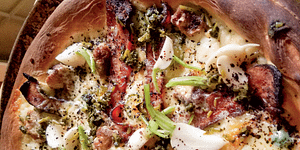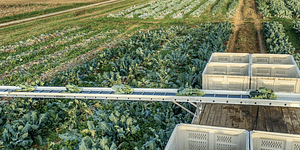All About Kale: The Evolution of This Popular Green

Kale is known as a delicious leafy green addition to meals and smoothies, but it didn’t always have the stellar reputation it does today. Once considered an undesirable vegetable mainly fed to cattle, kale has evolved over the years to become a powerful superfood.
The following is an excerpt from The Seed Detective by Adam Alexander. It has been adapted for the web.
The History of Kale
Our love affair with eating leafy brassicas in all their forms goes back at least 4,500 years. Kale most closely resembles the wild parents that archaeological and historical evidence now suggests were first domesticated in their native homelands of the Middle East and eastern Mediterranean.
It is likely that, prior to domestication, the wild parents would have been foraged principally for their oily seeds and that early domestication of mustard – a very close relative – could have begun about 12,000 years ago.
As a kid, I remember the national collective view of kale as being fit only for cattle and if anyone was idiotic enough to want to eat the stuff, the experience would be a sorry one. Tough, bitter, unpalatable and not improved with much boiling.
By the time I could afford to pay for my own dinner, Italian chefs had begun to test the conservative British palate with something called cavolo nero – literally translated as ‘black cabbage’ – a type of kale.
Kale Around the World: Different Varieties

Italians will no doubt hate me for saying this, but of all the wonderful varieties of vegetable emanating from that country cavolo nero is by far the least interesting.
I give it no space in my garden, preferring the many other delightful and tastier varieties I have discovered over the years.
The Americans bred their own delicious types, which they called collards, from the English word colewort meaning ‘cabbage’. A staple of Southern US cuisine, collard greens sprinkled with vinegar is my kind of food. One I grow regularly goes by the wonderful name of Georgia Southern Collard.
Asparugus Kale: A Brilliant Brassica
Travelling in the former Soviet Union, I soon became familiar with a number of different Russian variants. Unlike the narrow-leaved and almost tubular cavolo nero, Russian kale came in red and green, with large, serrated and frilly leaves. The Canadians had their own varieties too. Then, in the mid-1980s, I discovered asparagus kale.
This awesome brassica, bred in Scotland towards the end of the nineteenth century, was so named because the flower spikes which emerge in spring can be eaten blanched, like asparagus. Delicious. But, for me, the real joy of this variety is its profusion of tender, pale green leaves that are at their best when plucked in late winter and stir-fried with garlic.
Other Types of British Kale
I have been an advocate of asparagus kale ever since. It’s not the only brilliant British kale. Another is Ragged Jack, so named for its deeply serrated, dark green leaves. Not grown commercially for more than a century, it survived in Tunley in Somerset where it was known as Tunley Greens.
Another local variety is Black Jack from Tiverton in Devon, though back in the 1970s the grower was evidently keeping the crop to themselves because I never came across it when I lived in the neighbourhood.
Off One’s Kale: The Kale Revolution

The American botanist Edward Lewis Sturtevant (1842–1898), in his seminal work Sturtevant’s Edible Plants of the World, completed in 1887, describes a traveller in Scotland called Ray who wrote in 1661 that ‘people used much pottage made of coal-wort which they call keal’.6
So ubiquitous was kale that not only was the generic name for soup kail, but also the pot in which it was cooked. Even Scotland’s greatest poet Robert Burns (1759–1796) wrote of the vegetable’s importance in assisting in the amorous intentions of young lovers in his poem Halloween.
Modern Kale: A Foodie Favorite
Now, there is an ever-increasing number of foodies who love their kale, some even seeing it as a ‘superfood’ and eating sprouting seeds or making lurid green smoothies from the leaves, which is apparently meant to do them no end of good.
For some, their obsession for this once-despised vegetable extends to eating kale crisps with plenty of salt. I cannot think of another vegetable whose image has been so transformed in recent times.
Notes
6. Edward Lewis Sturtevant, Sturtevant’s Edible Plants of the World, ed. U.P. Hedrick (Geneva, NY: New York Agricultural Research Station, 1919), https://www.swsbm.com/Ephemera/Sturtevants_Edible_Plants.pdf.
Recommended Reads
Recent Articles
Want to spice up your traditional bread recipes? This salt-rising bread recipe by fermentation expert Sandor Ellix Katz has all the simplicity, flavor, and uniqueness you’ve been searching for! The following is an excerpt from Sandor Katz’s Fermentation Journeys by Sandor Ellix Katz. It has been adapted for the web. What Is Salt-Rising Bread? Salt-rising…
Read MoreNothing says “spring” like a fresh, foraged meal! Savor the flavors of the season with this Milkweed Bud Pizza recipe.
Read MoreOxeye daisies are one of the most important plants for pollinators including beetles, ants, and moths that use oxeye daisies as a source of pollen and nectar. Instead of thinking about removing a plant like oxeye daisy, consider how you can improve the fertility and diversity of habitat resources in your home landscape, garden, or…
Read MoreSo you want to start reaping your harvest, but you’re not sure where to start? Learn how to break down the options of harvesting tools!
Read More








